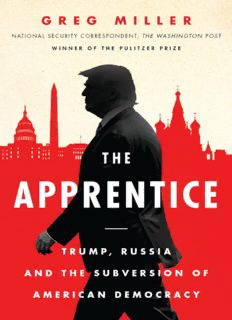
The Apprentice: Trump, Russia and the Subversion of American Democracy PDF
Preview The Apprentice: Trump, Russia and the Subversion of American Democracy
Dedication To Rebecca, Katie, Peter, and Cole For Mom and Dad Contents Cover Title Page Dedication Prologue Part One 1. The Hack 2. Putin’s Trolls 3. Moths to the Flame Part Two 4. “I Believe You Have Some Information for Us” 5. The Missing Emails 6. Crossfire Hurricane 7. Deep Inside the Kremlin Part Three 8. Dezinformatsiya 9. The Russian Ambassador 10. Briefing the President Part Four 11. You’re Fired 12. The Special Counsel Strikes Part Five 13. “I Can’t Put on the Charm” 14. Helsinki Epilogue Acknowledgments Notes Index Photo Section About the Author Also by Greg Miller Copyright About the Publisher Prologue T he warren of cubicles was secured behind a metal door. The name on the hallway placard had changed often over the years, most recently designating the space as part of the Mission Center for Europe and Eurasia. But internally, the office was known by its unofficial title: “Russia House.” The unit had for decades been the center of gravity at the CIA, an agency within the agency, locked in battle with the KGB for the duration of the Cold War. The department’s prestige had waned after the September 11 attacks, and it was forced at one point to surrender space to counterterrorism operatives. But Russia House later reclaimed that real estate and began rebuilding, vaulting back to relevance as Moscow reasserted itself. Here, among a maze of desks, dozens of reports officers fielded encrypted cables from abroad, and “targeters” meticulously scoured data on Russian officials, agencies, businesses, and communications networks the CIA might exploit for intelligence. Deeper inside was a conference room adorned with Stalin-era posters of heroically depicted Soviets, muscled soldiers and workers striding across fields or factories under the hammer and sickle. The room, swept routinely for listening devices, was the scene of increasingly tense meetings in the months leading up to the 2016 presidential election, as senior agency officials sought to make sense of a series of disconcerting reports. In late July, the agency had gained access to an extraordinary stream of information showing that Russian president Vladimir Putin was himself directing the “active measures” operation aimed at disrupting the U.S. presidential race. U.S. intelligence partners were also warning Russia House about worrisome contacts between Russian figures and campaign associates of the Republican nominee. Donald Trump’s vigorous displays of admiration for the Russian leader only made things more bewildering. He routinely praised Putin and even seemed to enlist Moscow in an effort to hack his opponent’s email account. The question was, why? Taking a hard line against Russia was the politically winning move, and yet Trump seemed subservient. Unlike any presidential candidate in memory, Trump had shielded his finances from public scrutiny. He refused to release his personal tax returns. His business empire was a labyrinth of separate companies registered under different names. Many of those he had done business with hid their identities behind corporate shells. Some of his most prominent developments were deep in debt, though how deep and to whom was nearly impossible to discern. During the campaign, there was consolation in the idea that Trump’s unsettling behavior toward Moscow was a product of inexperience—a problem that would be contained when he was surrounded by smarter advisers or wouldn’t matter anymore once he lost. But those inside U.S. spy agencies were privy to alarming secrets that were not so easily shrugged off. Among them was that the Kremlin was actively seeking to help elect Trump. Russia House was the point of origin for that assessment, which would later be embraced by the U.S. intelligence community and infuriate the 45th president. The Kremlin’s objectives began with sowing discord in American democracy, but broadened in mid-2016 to backing a specific candidate—who at this moment, his second day as leader of the free world, was making his way toward CIA headquarters. President Trump had barely been in office twenty-four hours when his motorcade departed the White House grounds for the nine-mile trip to the CIA’s Northern Virginia campus. The clouds and cold that had dampened Inauguration Day lingered over a city littered with the debris of America’s post-election divide—pro-Trump memorabilia, inauguration programs and celebratory banners along the parade route; broken windows and burned vehicles on blocks where protesters had clashed with police in riot gear. Trump’s arrival in the White House had been followed by a women’s march that drew a crowd three times larger than the inaugural audience,1 and now throngs of pink-clad activists watched the caravan accelerate through the D.C. streets. Their gestures toward the motorcade, countered by some salutes from Trump supporters wandering Washington, reflected in the thick tinted glass of the president’s passing car. The street-side crowds dissipated as the line of vehicles left downtown, crossed into Virginia, and followed the Potomac River north, turning onto the main route through the suburb of McLean and then past the zigzagging barricades that guard the entrance to the CIA. The agency occupies a sprawling, leafy campus in Northern Virginia enclosed by miles of electrified fence. At the center of the property is a seven-story building with a row of glass doors opening onto an iconic marble lobby—with the CIA seal inlaid in the terrazzo floor— frequently depicted in movies. The CIA welcome for Trump would be cordial, even warm, but it was by
Description: